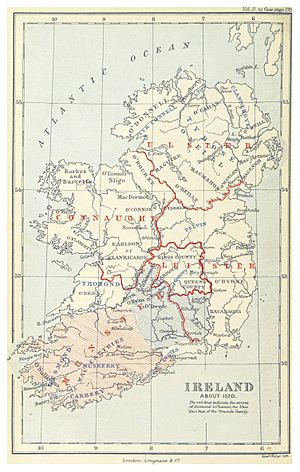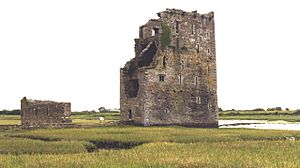Desmond Rebellions facts for kids
The Desmond Rebellions were two big fights that happened in Ireland between 1569 and 1583. They took place in a part of Ireland called Munster. These rebellions were led by the Earl of Desmond, who was the head of a powerful Irish family called the FitzGerald dynasty. He and his supporters, known as the Geraldines, fought against the English government.
The main reason for these rebellions was that the Irish lords wanted to keep their independence and not be controlled by the English King or Queen. There was also a religious difference, as the Geraldines were Catholic and the English government was Protestant. These wars ended with the Desmond family losing all their power. After that, English Protestant settlers were sent to live on the land in Munster. The name 'Desmond' comes from the Irish words Deasmumhain, which means 'South Munster'.
During these rebellions, the English forces used very harsh methods. They sometimes destroyed farms and homes to make it harder for the Irish people to find food or shelter. This was done to weaken the rebels and their supporters.
Contents
Why the Rebellions Started
For over 200 years, the southern parts of Ireland were mostly controlled by two powerful Irish families: the Butlers and the FitzGeralds of Desmond. These families had their own armies and made their own rules, which were a mix of Irish and English customs. They didn't really follow the English government's laws in Ireland.
Starting in the 1530s, English rulers tried to get more control over all of Ireland. By the 1560s, they focused on the south. Henry Sidney, who was the English leader in Ireland, wanted to set up "lord presidencies." These were like military governors who would take over the local lords' power and keep the peace.
The powerful Irish families saw these new English governors as a threat to their way of life. For example, in 1565, the Butlers and FitzGeralds even fought a battle against each other, which was against English law. Queen Elizabeth I called the leaders of both families to London to explain. However, she treated them differently. Thomas Butler, 10th Earl of Ormonde, who was the Queen's cousin, was forgiven. But Gerald FitzGerald, 14th Earl of Desmond, and his brother, John of Desmond, were arrested and held in the Tower of London.
This left the Desmond family without their main leaders. So, a soldier named James FitzMaurice FitzGerald became the leader of the Desmond army. He didn't like the idea of the Irish lords losing their armies. Many people also worried that the English would take their land. This fear made more people support FitzMaurice.
Important Irish families like the MacCarthy Mór and O'Sullivan Beare joined FitzMaurice. Even some of the Butler family members, who were brothers of the Earl, joined him. FitzMaurice himself had lost his land to English settlers. He was also a very religious Catholic and saw the Protestant English rulers as his enemies.
FitzMaurice wanted to stop the English from setting up their new government in Munster. He also wanted to bring back the Desmond family's power over the Butlers. He even secretly asked King Philip II of Spain for military help to start a bigger rebellion against the English.
First Desmond Rebellion (1569–1573)
Quick facts for kids First Desmond Rebellion |
|||||||
|---|---|---|---|---|---|---|---|
| Part of the Desmond Rebellions | |||||||
|
|||||||
| Belligerents | |||||||
Allied clans |
|||||||
| Commanders and leaders | |||||||
| -James FitzMaurice FitzGerald | -Henry Sidney -Thomas Butler -Humphrey Gilbert -John Perrot (1571–1573) |
||||||
| Strength | |||||||
| 4,500 | Unknown | ||||||
| Casualties and losses | |||||||
|
Unknown 700 executed |
Unknown | ||||||
The first rebellion began in June 1569. FitzMaurice and his 4,500 men first attacked an English settlement near Cork. Then they attacked Cork itself and other Irish lords who didn't join them. In July, they tried to capture Kilkenny, which was the home of the Earls of Ormonde.
In response, Henry Sidney gathered 600 English soldiers from Dublin. Another 400 soldiers arrived by sea in Cork. The Earl of Ormonde, Thomas Butler, also returned from London and brought together his family's forces and other Irish groups who didn't like the Geraldines. After failing to take Kilkenny, the rebellion started to fall apart.
Ormonde, Sidney, and Humphrey Gilbert, who was made governor of Munster, began destroying the lands of FitzMaurice's allies. This was a "scorched earth" tactic, meaning they burned crops and homes to leave nothing for the rebels. FitzMaurice's forces broke up as each lord had to go back to defend their own lands.
Sidney pushed FitzMaurice into the mountains of Kerry. From there, FitzMaurice launched small, surprise attacks on the English. By 1570, most of FitzMaurice's allies had given up. Donal MacCarthy Mór, an important leader, surrendered in November 1569. But FitzMaurice continued his guerrilla war for three more years.
In February 1571, John Perrot became the new English leader in Munster. He chased FitzMaurice with 700 soldiers for over a year but couldn't catch him. FitzMaurice did have some small victories, like capturing an English ship and burning the town of Kilmallock in 1571. But by early 1573, his group had fewer than 100 men left. FitzMaurice finally surrendered on February 23, 1573, and was pardoned. However, he lost his land. In 1575, he sailed to France to ask Catholic countries for help to start another rebellion.
After the rebellion, Gerald FitzGerald, the Earl of Desmond, and his brother John were released from prison. They had to rebuild their lands. The English made new rules, limiting the Desmonds' army to only 20 horsemen. Their tenants (people living on their land) now had to pay rent instead of providing military service. The Earl of Ormonde, who had sided with the English, became the most powerful lord in southern Ireland.
All the local chiefs had surrendered by the end of the rebellion. But the harsh ways the English used to stop the rebellion caused lasting anger, especially among Irish soldiers called gallowglass. William Drury, an English leader in Munster, had about 700 of these men executed in the years after the rebellion.
After the uprising, many traditional Irish customs were outlawed again. These included Irish laws, Irish clothing, and having "private armies." FitzMaurice had strongly supported Irish ways during the rebellion, wearing Irish clothes and speaking only Irish. Irish landowners also continued to worry about English settlers taking their land. Because of all these reasons, when FitzMaurice returned from Europe, many people in Munster were ready to join him again.
In late 1569, a Catholic rebellion called the Northern Rebellion happened in England, but it was quickly stopped. This, along with the Desmond Rebellion, led Pope Pius V to declare that Queen Elizabeth I was no longer a true Christian ruler. This meant that Catholics were not supposed to be loyal to her. Before this, Elizabeth had allowed Catholics to practice their faith privately. But now, she became stricter against strong Catholic beliefs. Luckily for her, most Irish Catholics did not want to join rebellions, even though they remained Catholic.
Second Desmond Rebellion (1579–1583)
The second Desmond Rebellion began when James FitzMaurice FitzGerald returned to Munster in 1579. While he was away in Europe, he had become a strong supporter of the Catholic Church. He argued that since the Pope had declared Elizabeth I not a true Christian, Irish Catholics did not have to be loyal to her. The Pope gave FitzMaurice special permission and sent him soldiers and money. FitzMaurice landed in Ireland with a small group of Spanish and Italian soldiers on July 18, 1579. On August 1, John of Desmond, the Earl's brother, joined him with many of his family and other unhappy soldiers from Munster. Other Irish families and Old English families also joined the rebellion.
FitzMaurice was killed in a small fight on August 18. John FitzGerald then took over as the leader of the rebellion.
Gerald, the Earl of Desmond, at first tried to stay out of the rebellion. But once the English government called him a traitor, he joined the fight. He attacked and looted towns like Youghal and Kinsale. He also destroyed the lands of the English and their allies.
In the summer of 1580, English soldiers led by William Pelham and Irish forces led by the Earl of Ormonde fought back. They took over the south coast, destroying the lands of the Desmonds and their allies. They also killed many people living on their lands. At Easter 1580, they captured Carrigafoyle Castle, which was an important Desmond castle. This cut off the Geraldine forces and stopped foreign soldiers from landing in Munster's main ports.
In July 1580, the rebellion spread to another part of Ireland called Leinster. It was led by Fiach MacHugh O'Byrne. On August 25, his forces surprised and defeated a large English army led by Lord Grey de Wilton at the battle of Glenmalure.
On September 10, 1580, 600 soldiers sent by the Pope landed in Kerry to help the rebellion. They were surrounded in a fort. After two days of attacks, they surrendered and were then killed. The English continued their harsh tactics, destroying animals, crops, and homes to leave the Irish with no food or shelter. By mid-1581, the rebellion was mostly crushed. By May 1581, most of the smaller rebel groups and FitzGerald's allies in Munster and Leinster had accepted Queen Elizabeth I's offer of a pardon. John of Desmond was killed near Cork in early 1582.
The Earl of Desmond was hunted by English forces until the very end. From 1581 to 1583, his supporters hid in the mountains of Kerry. On November 2, 1583, the Earl was found and killed near Tralee in Kerry by the O'Moriarty family and English soldiers. His head was sent to Queen Elizabeth. His body was put on display in Cork.
What Happened After the Rebellions
After three years of harsh warfare by the English, Munster was suffering from a terrible famine. In April 1582, an English official estimated that 30,000 people had died of hunger in just six months. A disease also broke out in Cork city, where many people had fled to escape the fighting. People continued to die from hunger and disease long after the war ended. It's thought that by 1589, one-third of the people in Munster had died. Lord Grey, the English leader, was called back by Queen Elizabeth I because he had been too brutal.
The wars of the 1570s and 1580s changed Ireland forever. The powerful Desmond family was destroyed. Munster was then "planted" with English settlers. These settlers were given land that had been taken from the Irish people who fought in the rebellion. This "Munster Plantation" was part of the larger plan by the English to take control of all of Ireland. This plan continued with the Nine Years War in another part of Ireland called Ulster, and then more land was settled by English people across the country.
See also
- List of Irish rebellions
- Tudor conquest of Ireland
- Early Modern Ireland 1536-1691




